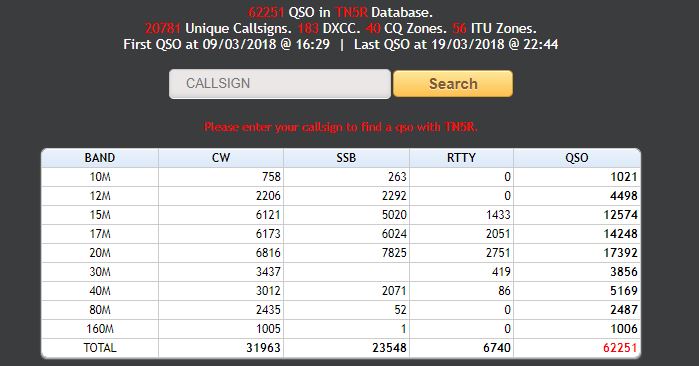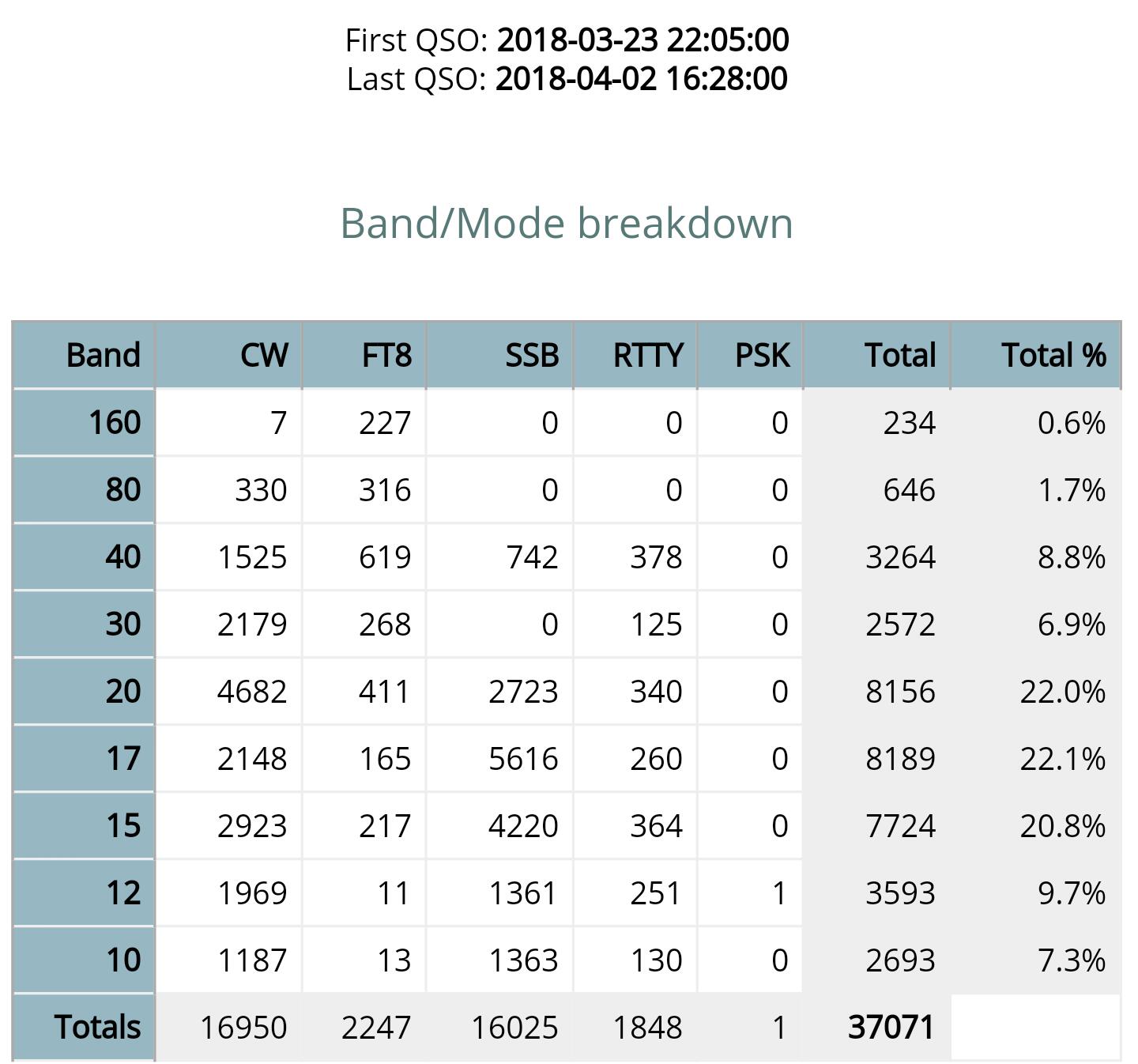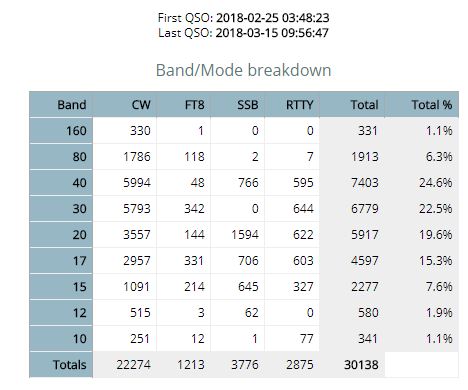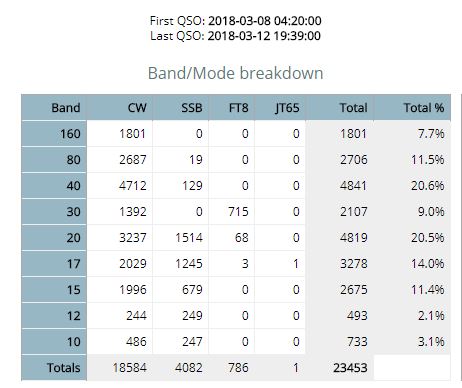This article was originally written by Enrico IZ5CML and then translated by Fabrizio IU0BMP.
In this days, a bunch of Dxpeditions have been conducted, livening up the HF bands in the last few weeks. Propagation has been poor, but sometimes these Dxpeditions have given us some fun on several bands, even on the high ones.
This has been an ideal testing ground, especially in these really marginal conditions, to see how the FT8 mode performs when it is used by Dxpeditions. We now have some facts to discuss, not just ‘pro or con’ theories.
Some of these operations have used FT8, some have not. Among those which have used FT8, TY7C is known for having chosen the “Dxpedition mode”, that makes it possible to run simultaneous QSOs, dramatically increasing the QSO rate.
9M0W, 3D2EU, XR0YD (and other minor operations) have also used FT8.
Well, the first “strong” and evident result is that, in none of these operations, the FT8 QSOs exceeded, matched or even came close to the CW or SSB numbers. This may sound obvious, but, given the huge FT8 popularity in daily QSOs made by dozens of thousand hams, it was not to be taken for granted.
As a matter of facts, the FT8 QSOs have not even exceeded those of “poor and old” RTTY, being, in many cases a lot less, if not half as many, and sometimes a few less.
CW still goes really strong. In all the Dxpeditions it is, by far, the most used mode, even 150% more than the other modes.
So far, the most “prolific” operation has been TN5R, with over 62,000 QSOs, without using FT8, only RTTY as a digital mode. Most QSOs were with North America and then with Europe, a very good result. They also put a greater deal of effort into SSB, compared to the other Dxpeditions.

Then there is 3C0W with its 54,000 QSOs and only three LY operators, that have done really well. They have operated mostly CW, but also SSB and RTTY. You should also add the 30,000 QSOs made as 3C3W. They didn’t use FT8 at all.

TJ2TT, the umpteenth African Dxpedition by the very Italian IDT, made about 50,000 QSOs, not bad for the current conditions, reaching the third place in our ranking, working in CW, SSB RTTY, and no FT8.
XR0YD made 46,000 QSOs, with almost 5,000 in FT8 (more than 10% of total QSOs). This was the Dxpedition that made most FT8 contacts and almost 6,400 in RTTY. The digital modes have exceeded SSB!
Unlike other Dxpeditions, they tried to use FT8 as a mode for very marginal conditions, on the more extreme bands, 10 and 160 meters, but, in 10 meters, there were more RTTY contacts than FT8, whereas in 160 meters, where they didn’t run RTTY, the FT8 share wasn’t so great with only 126 QSOs against 910 CW contacts… and if you wish to spend some time on it, you could see that a lot of them are not unique, that is, those who worked XR0YD in FT8 on 160 meters are the same who worked them on 160 CW…

TY7C was another Dxpedition putting a lot of effort into FT8 and digital modes in general, with a lot of RTTY, but looking at the spots and according to the team, they devoted a lot of time to FT8, having asked K1JT to use the Dxpedition mode.
They made many FT8 contacts, 3,100, but less than XR0YD, that didn’t use the Dxpedition mode. I remind you that the Dxpedition mode should allow to make simultaneous QSOs, for a theoretical 500 QSOs per hour…
Anyway, RTTY is still ahead, not to mention CW QSOs, which were the vast majority.
Total QSOs were just short of 40,000. That’s 22,000 less than TN5R, which had a similar duration, geographic zone, number of operators and equipment and also 10,000 less than TJ2TT, again from a similar geographic zone, less operators and equipment for the IDT.
Please note, we are not judging who is “good” or who is “bad”. They all deserve a lot of praises for venturing in such unsafe and awkward countries. We only intend to compare similar Dxpeditions to note the differences.

7Q7EI made 37,000 QSOs, not bad; the Dxpedition of the Irish guys is quite an exception: they made few contacts in FT8 in general, (even running the Dxpedition mode…), totalling 2247 (less than 7%). But on the low bands, 80 and 160 meters, they operated almost exclusively in FT8, making very few contacts (a few hundred ...), supposedly due to high noise levels, but when I heard them in CW one of the last nights in 80 meters, they were strong and had a “normal” QSO rate. It didn’t seem like they were having trouble hearing.
As a matter of fact, no other recent African Dxpedition (including Z2LA, that we didn’t consider in this article having made less than 20,000 QSOs…) has made less contacts in 80 and 160 meters. Noise or not, FT8 does not seem a good replacement for other modes.

3D2EU, 30,000 QSOs, another operation where digital modes exceeded phone and where CW took the lion’s share, with FT8 accounting for less than half the RTTY total. Again, also in this case, I have the same thoughts I had about XR0YD on marginal bands, where in theory FT8 should perform a bit better due to its excellent “signal to noise ratio”; yet the results are not those one could expect: on 80 meters, only 118 QSOs out of 1,900, 1 on 160 meters... on 10 meters, there are more QSOs in RTTY than FT8, and again, if you want to spend some time investigating, you would find that a very large part of the hams who worked this Dxpedition in FT8 on the toughest bands also worked it in other modes, just to fill some slots. Should they be blamed? Of course not, but this is useful to put things in perspective and get the whole picture.

Finally 9M0W. 23,000 QSOs are not a lot, given how ‘wanted’ this entity is and the ‘first class’ team operating there. Among the members there was Hrane YT1AD and other well known operators. One could expect more, but it must be said that it lasted only 5 days instead of the 10-15 days of the other operations we have considered.
They operated in FT8 as the only digital mode, neglecting RTTY, and ran the Dxpedition mode too, which had been introduced only a few days before and many hams didn’t know how to use it properly and called according to the normal procedure, adding to the chaos.
This is, in my opinion, the most significant result because they chose not to make RTTY, replacing it with FT8. From a ‘digital’ point of view, it is disappointing, only 780 QSOs… From Spratly in RTTY, they could have made that many in a single afternoon. Very few contacts...

The comparison between TY7C (having made use of FT8, also in Dxpedition mode) and TJ2TT and TN5R (no FT8 for them), all in Africa, in the same time frame (hence sharing the same propagation conditions…) with the same activity duration and similar number of operators (TJ2TT had a smaller team…) gives quite an objective result: FT8 does not bring significant benefits, concerning the number of QSOs, unique contacts, nor in marginal bands (160 and 10 meters), even in Dxpedition mode (at least for now..). Looking at the numbers, it seems to cause a waste of time, to the detriment of more efficient modes in terms of number of contacts (not to mention a ham’s personal enjoyment, but this is a subjective matter…)
Is it right, is it wrong? The main Dxpedition goal, especially for medium to large scale operations, has always been to make as many QSOs as possible, while trying to favor unique contacts; is FT8 an useful tool to achieve or improve all this? At the moment, it just does not seem so, only adding to the number of slots for those hams already having contacts in other modes.
By peeking at online logs, with a few friends’ call signs or other hams’ who are known for working several different modes, you can see that the vast majority of the stations that are in the FT8 logs, are the same stations that appear in the CW, SSB or RTTY logs. FT8 is simply a mode to add more slots in a Dxpedition, not a mode to make QSOs that would be otherwise impossible, as some would like us to believe.
I think that FT8 can be considered in those Dxpeditions featuring many active stations and many operators, that can afford to run one station in FT8 too, when the bands are not open for other modes (also to experiment possible marginal openings), being careful not to cross this “limit”, missing out on QSOs in more “profitable” modes. It’s a situation that should be avoided by medium scale Dxpedition, that should rather take advantage of the limited available time and stations.
Therefore, as a conclusion, FT8, if used by Dxpeditions, does not make it big, does not match or exceed RTTY, although it is growing. A few months ago, there were very few operations running it, or contacts were very few. Now they have increased, although still to a small extent globally (ranging between 2 and 9% of Dxpeditions QSO totals, when used), and, by looking carefully, it appears that the Dxpeditions that used it a lot have not got many meaningful benefits in terms of QSOs or unique contacts or marginal bands, rather it seems the contrary. We will see when there are more samples to analyze, but anyway these numbers are already enough to get a basic idea.
In my opinion, it is not a mode for massive QSOs. About marginal band openings in this current solar minimum conditions, I believe that there are few, if any, HF marginal openings, (unlike 6 meters, where they are a common occurrence). Either there are suitable conditions for the traditional modes, or the band is completely closed, and that’s it, end of the story.
I think that this will, at least, cool down those who regard it as a new mode to replace all the other ones, CW, SSB, RTTY… Maybe they will have to reconsider their predictions, a bit like those foreseeing people living on Mars by the year 2000 or driving flying cars, you know.
Maybe FT8 can be added to RTTY, yes, fine, but do not spend too much time on it or the QSO number will inevitably fall and so will the number of happy hams.
In this days, a bunch of Dxpeditions have been conducted, livening up the HF bands in the last few weeks. Propagation has been poor, but sometimes these Dxpeditions have given us some fun on several bands, even on the high ones.
This has been an ideal testing ground, especially in these really marginal conditions, to see how the FT8 mode performs when it is used by Dxpeditions. We now have some facts to discuss, not just ‘pro or con’ theories.
Some of these operations have used FT8, some have not. Among those which have used FT8, TY7C is known for having chosen the “Dxpedition mode”, that makes it possible to run simultaneous QSOs, dramatically increasing the QSO rate.
9M0W, 3D2EU, XR0YD (and other minor operations) have also used FT8.
Well, the first “strong” and evident result is that, in none of these operations, the FT8 QSOs exceeded, matched or even came close to the CW or SSB numbers. This may sound obvious, but, given the huge FT8 popularity in daily QSOs made by dozens of thousand hams, it was not to be taken for granted.
As a matter of facts, the FT8 QSOs have not even exceeded those of “poor and old” RTTY, being, in many cases a lot less, if not half as many, and sometimes a few less.
CW still goes really strong. In all the Dxpeditions it is, by far, the most used mode, even 150% more than the other modes.
So far, the most “prolific” operation has been TN5R, with over 62,000 QSOs, without using FT8, only RTTY as a digital mode. Most QSOs were with North America and then with Europe, a very good result. They also put a greater deal of effort into SSB, compared to the other Dxpeditions.
Then there is 3C0W with its 54,000 QSOs and only three LY operators, that have done really well. They have operated mostly CW, but also SSB and RTTY. You should also add the 30,000 QSOs made as 3C3W. They didn’t use FT8 at all.
TJ2TT, the umpteenth African Dxpedition by the very Italian IDT, made about 50,000 QSOs, not bad for the current conditions, reaching the third place in our ranking, working in CW, SSB RTTY, and no FT8.
XR0YD made 46,000 QSOs, with almost 5,000 in FT8 (more than 10% of total QSOs). This was the Dxpedition that made most FT8 contacts and almost 6,400 in RTTY. The digital modes have exceeded SSB!
Unlike other Dxpeditions, they tried to use FT8 as a mode for very marginal conditions, on the more extreme bands, 10 and 160 meters, but, in 10 meters, there were more RTTY contacts than FT8, whereas in 160 meters, where they didn’t run RTTY, the FT8 share wasn’t so great with only 126 QSOs against 910 CW contacts… and if you wish to spend some time on it, you could see that a lot of them are not unique, that is, those who worked XR0YD in FT8 on 160 meters are the same who worked them on 160 CW…

TY7C was another Dxpedition putting a lot of effort into FT8 and digital modes in general, with a lot of RTTY, but looking at the spots and according to the team, they devoted a lot of time to FT8, having asked K1JT to use the Dxpedition mode.
They made many FT8 contacts, 3,100, but less than XR0YD, that didn’t use the Dxpedition mode. I remind you that the Dxpedition mode should allow to make simultaneous QSOs, for a theoretical 500 QSOs per hour…
Anyway, RTTY is still ahead, not to mention CW QSOs, which were the vast majority.
Total QSOs were just short of 40,000. That’s 22,000 less than TN5R, which had a similar duration, geographic zone, number of operators and equipment and also 10,000 less than TJ2TT, again from a similar geographic zone, less operators and equipment for the IDT.
Please note, we are not judging who is “good” or who is “bad”. They all deserve a lot of praises for venturing in such unsafe and awkward countries. We only intend to compare similar Dxpeditions to note the differences.

7Q7EI made 37,000 QSOs, not bad; the Dxpedition of the Irish guys is quite an exception: they made few contacts in FT8 in general, (even running the Dxpedition mode…), totalling 2247 (less than 7%). But on the low bands, 80 and 160 meters, they operated almost exclusively in FT8, making very few contacts (a few hundred ...), supposedly due to high noise levels, but when I heard them in CW one of the last nights in 80 meters, they were strong and had a “normal” QSO rate. It didn’t seem like they were having trouble hearing.
As a matter of fact, no other recent African Dxpedition (including Z2LA, that we didn’t consider in this article having made less than 20,000 QSOs…) has made less contacts in 80 and 160 meters. Noise or not, FT8 does not seem a good replacement for other modes.

3D2EU, 30,000 QSOs, another operation where digital modes exceeded phone and where CW took the lion’s share, with FT8 accounting for less than half the RTTY total. Again, also in this case, I have the same thoughts I had about XR0YD on marginal bands, where in theory FT8 should perform a bit better due to its excellent “signal to noise ratio”; yet the results are not those one could expect: on 80 meters, only 118 QSOs out of 1,900, 1 on 160 meters... on 10 meters, there are more QSOs in RTTY than FT8, and again, if you want to spend some time investigating, you would find that a very large part of the hams who worked this Dxpedition in FT8 on the toughest bands also worked it in other modes, just to fill some slots. Should they be blamed? Of course not, but this is useful to put things in perspective and get the whole picture.
Finally 9M0W. 23,000 QSOs are not a lot, given how ‘wanted’ this entity is and the ‘first class’ team operating there. Among the members there was Hrane YT1AD and other well known operators. One could expect more, but it must be said that it lasted only 5 days instead of the 10-15 days of the other operations we have considered.
They operated in FT8 as the only digital mode, neglecting RTTY, and ran the Dxpedition mode too, which had been introduced only a few days before and many hams didn’t know how to use it properly and called according to the normal procedure, adding to the chaos.
This is, in my opinion, the most significant result because they chose not to make RTTY, replacing it with FT8. From a ‘digital’ point of view, it is disappointing, only 780 QSOs… From Spratly in RTTY, they could have made that many in a single afternoon. Very few contacts...
The comparison between TY7C (having made use of FT8, also in Dxpedition mode) and TJ2TT and TN5R (no FT8 for them), all in Africa, in the same time frame (hence sharing the same propagation conditions…) with the same activity duration and similar number of operators (TJ2TT had a smaller team…) gives quite an objective result: FT8 does not bring significant benefits, concerning the number of QSOs, unique contacts, nor in marginal bands (160 and 10 meters), even in Dxpedition mode (at least for now..). Looking at the numbers, it seems to cause a waste of time, to the detriment of more efficient modes in terms of number of contacts (not to mention a ham’s personal enjoyment, but this is a subjective matter…)
Is it right, is it wrong? The main Dxpedition goal, especially for medium to large scale operations, has always been to make as many QSOs as possible, while trying to favor unique contacts; is FT8 an useful tool to achieve or improve all this? At the moment, it just does not seem so, only adding to the number of slots for those hams already having contacts in other modes.
By peeking at online logs, with a few friends’ call signs or other hams’ who are known for working several different modes, you can see that the vast majority of the stations that are in the FT8 logs, are the same stations that appear in the CW, SSB or RTTY logs. FT8 is simply a mode to add more slots in a Dxpedition, not a mode to make QSOs that would be otherwise impossible, as some would like us to believe.
I think that FT8 can be considered in those Dxpeditions featuring many active stations and many operators, that can afford to run one station in FT8 too, when the bands are not open for other modes (also to experiment possible marginal openings), being careful not to cross this “limit”, missing out on QSOs in more “profitable” modes. It’s a situation that should be avoided by medium scale Dxpedition, that should rather take advantage of the limited available time and stations.
Therefore, as a conclusion, FT8, if used by Dxpeditions, does not make it big, does not match or exceed RTTY, although it is growing. A few months ago, there were very few operations running it, or contacts were very few. Now they have increased, although still to a small extent globally (ranging between 2 and 9% of Dxpeditions QSO totals, when used), and, by looking carefully, it appears that the Dxpeditions that used it a lot have not got many meaningful benefits in terms of QSOs or unique contacts or marginal bands, rather it seems the contrary. We will see when there are more samples to analyze, but anyway these numbers are already enough to get a basic idea.
In my opinion, it is not a mode for massive QSOs. About marginal band openings in this current solar minimum conditions, I believe that there are few, if any, HF marginal openings, (unlike 6 meters, where they are a common occurrence). Either there are suitable conditions for the traditional modes, or the band is completely closed, and that’s it, end of the story.
I think that this will, at least, cool down those who regard it as a new mode to replace all the other ones, CW, SSB, RTTY… Maybe they will have to reconsider their predictions, a bit like those foreseeing people living on Mars by the year 2000 or driving flying cars, you know.
Maybe FT8 can be added to RTTY, yes, fine, but do not spend too much time on it or the QSO number will inevitably fall and so will the number of happy hams.

Commenta